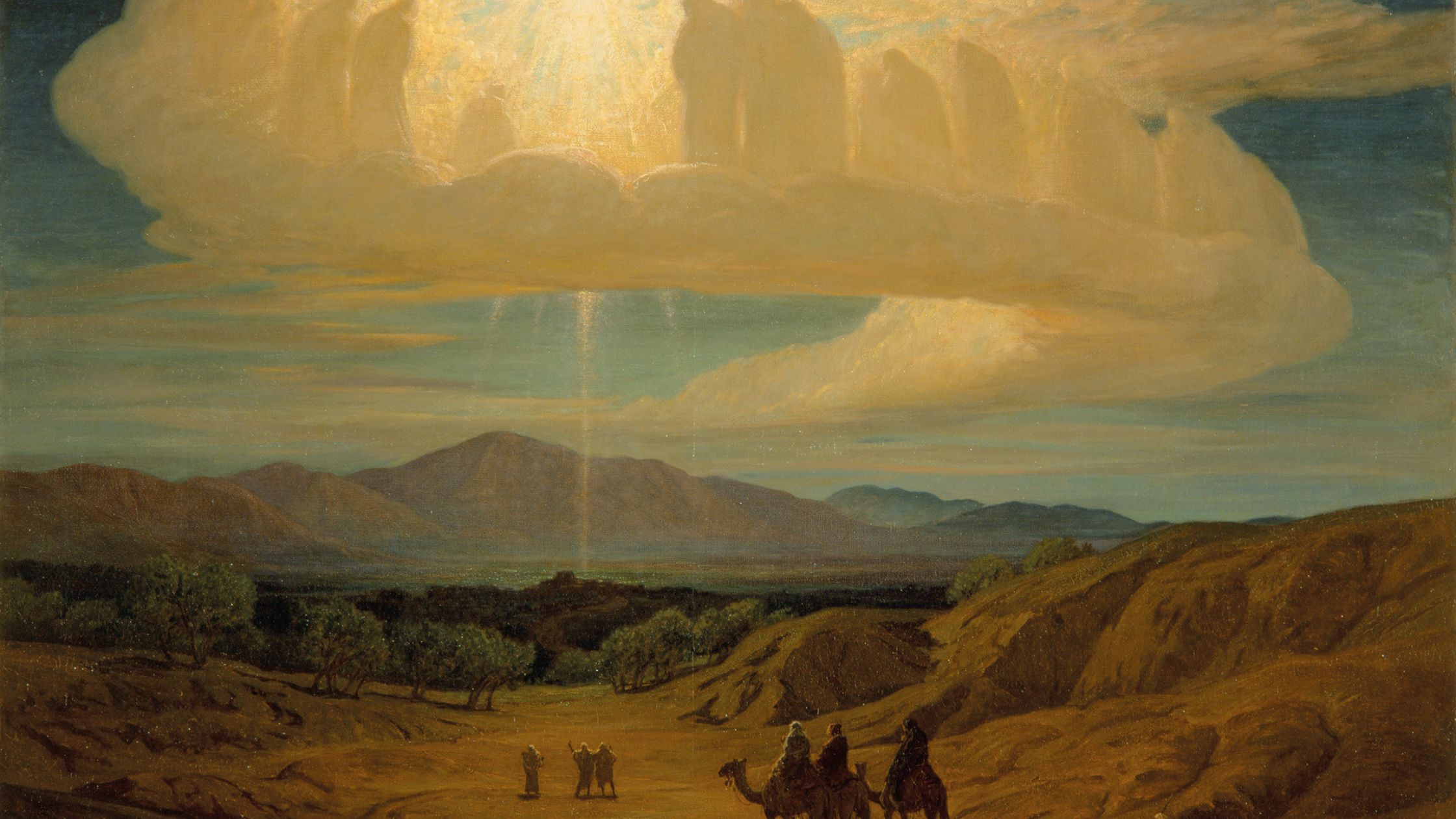Note: This blog contains references to astrology, which the Catholic Church condemns, including the use of horoscopes (CCC 2116). However, at the time of Jesus’ birth, a form of Hellenistic astrology was very popular, and with the notable exception of the Jews, the people of the Near East generally believed in fate and the ability of astrologers to predict the future. For this reason, this blog will look into this First-Century understanding of astrology to find the meaning of the Star of Bethlehem. However, CTS does not condone or encourage astrology.
Moreover, since the Magi read a message in the stars that we, as Christians, know to be true, it may be tempting to believe that we have to allow for the possibility that astrology ‘works’. However, as Pope Benedict XVI stated: “… it is not the star that determines the child’s destiny, it is the child that directs the star.”
This blog is based on The Star of Bethlehem by Fr Douglas McGonagle, which has been declared free from doctrinal or moral error.
1. The Story of the Magi and the Star is only in Matthew’s Gospel
Matthew’s account is all we ever hear about a star. As popular and thought-provoking an image as it is, it is all the first-hand information we have about the star. Matthew was trying to convey an important message in his account of the star, as Fr Douglas McGonagle, astrophysicist-turned-Catholic priest suggests: “namely, that even Gentiles, represented by pagan astrologers from the east, recognised that Jesus was God. Matthew writes about the Magi finally arriving in Bethlehem, describing how, on entering the house, “they saw the child with Mary his mother and fell down and they worshipped” (Mt 2:11). Today, we carelessly throw around words like “worship”; however, for Matthew, “worshipped” (προσεκύνησαν) is used to refer to the divine.
Fr Douglas continues: “Matthew includes the star in his nativity story for a reason. The Star of Bethlehem is not an ignis fatuus, a willo’-the-wisp. No less a scholar than Pope Benedict XVI believed in the historicity of Matthew’s Gospel. He firmly holds that the first two chapters of the Gospel dedicated to the infancy narrative are not merely “a meditation presented under the guise of history”. Pope Benedict insists: “Matthew is recounting real history, theologically thought through and interpreted, and thus he helps us to understand the mystery of Jesus more deeply.”
2. The Star of Bethlehem didn’t behave as a star should
“First of all,” Fr Douglas explains, “the star is conspicuous enough to catch the attention of the Magi – so conspicuous, in fact, that they packed up and headed off to Jerusalem to find the newborn king of the Jews. Yet the star is seemingly invisible to Herod, the chief priest and the scribes, and all of Jerusalem. Apparently, the arrival of the Magi is the first they have heard of any star.
“The star also has some peculiar properties: it rises in the east, but then proceeds before the Magi as they travel west, before stopping over the place where the child was. Not many stars in my experience can pull off those tricks. But wait a minute. If the star hovered over the place where Jesus was, why, then, did the Magi go first to Jerusalem to ask where the new King was to be born?It is all very puzzling, and many people, over the centuries, have tried to solve the riddle of this most peculiar star.”
3. The Star was an astrological event.
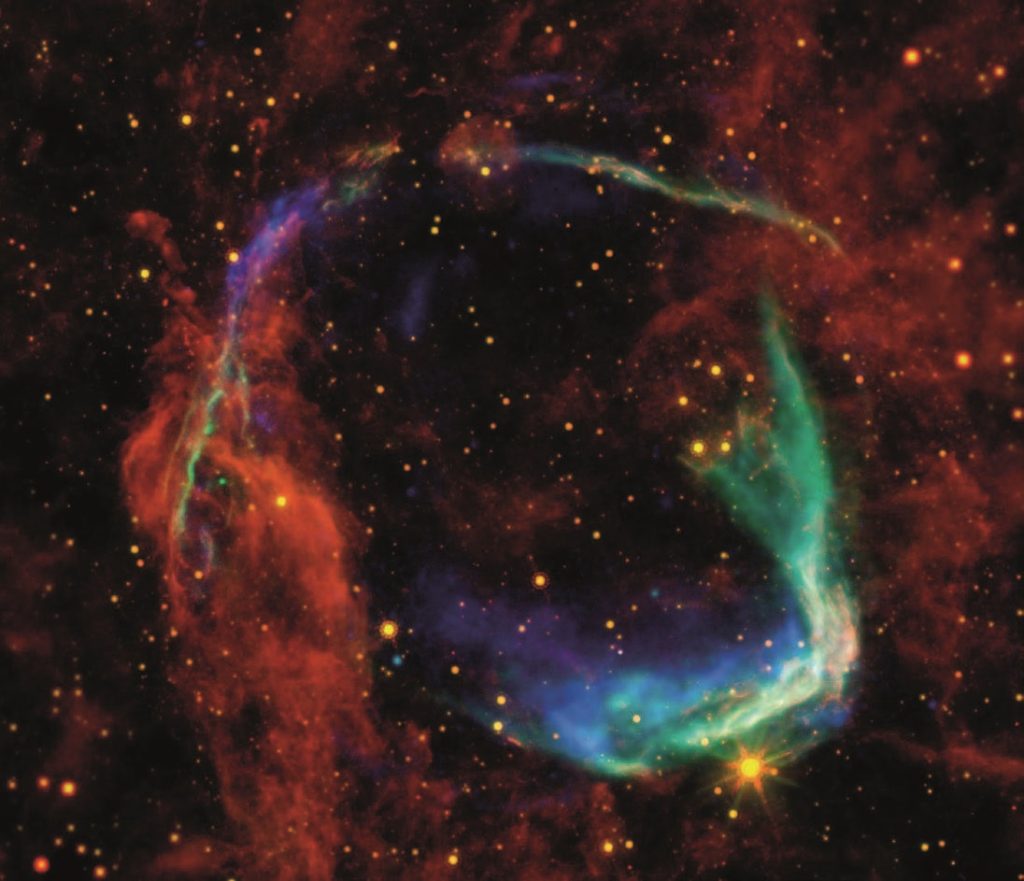
Supernova RCW 86 was observed towards the southern constellation of Circinus in AD 185 by Chinese astronomers. This is currently the earliest known naked-eye supernova for which supernova remnants have been identified by modern astronomers.
We can tell this both from what we know of people of the time (“We know that the ancients were interested in conjunctions and occultations not as natural events but as astrological omens,” says Fr Douglas.), by our knowledge of the Magi being astrologers, but also by eliminating every other possibility.
It was not a messenger from God. To begin with, Matthew told stories of angels – the angel appearing to Joseph to tell him that Mary had conceived of the Holy Spirit, and later an angel telling Joseph to take the Holy Family to Egypt, away from Herod. Matthew’s familiarity with angels and the fact that he insists on calling what the Magi see “a star” tells us that it is not an angel at all.
It was not a comet. Fr Douglas acknowledges that “Comets, like the Star of Bethlehem, appear to drift against the backdrop of the stars in the night sky … However, comets are often seen as bad omens … which does not fit with the Magi’s reaction: “When they saw the star, they rejoiced exceedingly with great joy” (Mt 2:10).”
It was not a supernova. “The remnants of supernova explosions litter our galaxy. Astronomers can analyse them and have a fair idea of when the explosion occurred.” Yet, Fr Douglas points out the problem this presents: “There are seven naked-eye supernovae in the historical record for which astronomers can identify a likely stellar corpse.” The earliest recorder was in AD 185, which would be far too late for it to be the Star of Bethlehem. While Chinese records do hint of another appearing 134 BC, but this would be far too early for it to be at the time of Jesus’ birth.
It was not a conjunction. Fr Douglas provides a brief explanation of a conjunction: “Conjunctions are the clustering of two or more celestial bodies in close proximity as they appear in the sky. If one object actually passes in front of another it is called an occultation. If the objects involved in the occultation are the Sun and the Moon, we call it an eclipse.” It has often been suggested in the past that the Star of Bethlehem could have been a conjunction of planets. However, Fr Douglas points out why this would not have been the case: “Though conjunctions and occultations can be quite beautiful, they are nowhere near as flashy as a good comet or a nearby supernova. They are also not particularly rare.”
It was not mythical. Another possible explanation for the Star is that it didn’t exist at all. Perhaps Matthew, wishing to show the importance of Jesus’ birth, simply added the star. However, there is no evidence that his Gospel ever engaged in deception. We have no reason to doubt Matthew and every reason to believe that the Star of Bethlehem actually existed.
3. There is historical evidence suggesting the existence of this star
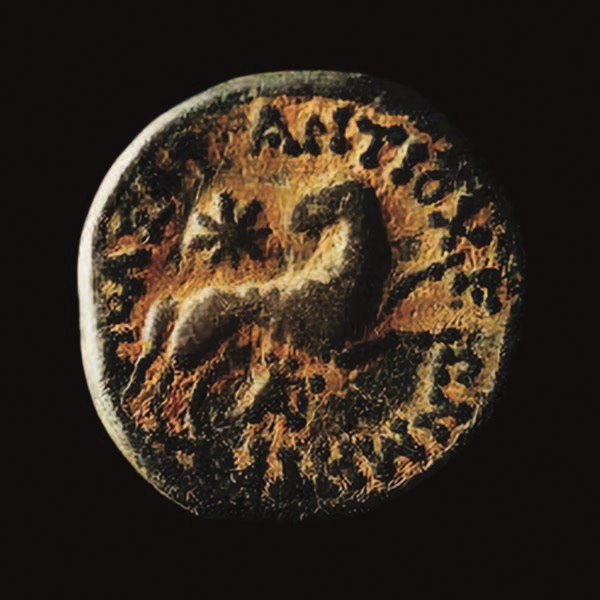
Bronze coins depicting a leaping ram looking back over its shoulder at a star first begin to appear on coins minted in Antioch c. AD 5-11. This example comes from the Molnar collection, PRC-1 4265.
When an astronomer who also happened to be an amateur collector of ancient coins, Dr Michael Molnar, came across several Roman provincial coins minted in the city of Antioch around the year AD 6 (when a man named Quirinius governed Syria – the same Quirinius Christians may remember from St Luke’s account of the Nativity) which had something rather puzzling on the back. While on one side of the coin was an image of Zeus, the other side revealed a leaping ram looking backwards at a star. Could this star be connected with the star that the Magi followed in Matthew’s Gospel?
A common practice during the Roman Empire was for cities and client kingdoms to mint their own coinage, with the “heads” side depicting the emperor or local deity (hence, Zeus) and the “tails” side used for political or religious promotion. This is a practice that continues today, for example with the 50p often used to commemorate important national events.
Another common practice at the time was cities or countries identifying themselves by using the sign of the zodiac that ruled over them on their coins. We can understand then that the ram featured on the back of this coin was intended to represent the astrological sign Aries. The Syrian city of Antioch used this ram on their coins for two hundred years, though not until AD 6, the year that Judea was annexed to Syria. This happened after the death of Herod the Great in 4 BC, with Quirinius (again, the same Quirnius from Luke’s Nativity story), the governor of Syria, being sent to bring Judea under direct Roman rule.
We can understand the meaning of the ram on the back of the coin, then, but what would be the reason for this star? Particularly, on a low denomination coin presumably in wide circulation at the time? What was it supposed to promote?
A key point to remember is that coinage in ancient Rome was the primary way in which Roman propaganda could be spread. Knowing this, when Dr Molnar’s research discovered that Aries was the astrological sign for Judea, he asked himself (in the words of Fr Douglas): “could [Rome] perhaps have been sensitive to rumours amongst astrologers of a regal portent in Aries, which the locals believed heralded a Messiah?”
“If so,” Fr Douglas continues, “could the coins be an attempt by Rome to subvert that apparition by saying that, yes, there was a regal portent in Aries, but it signified Caesar’s abolishing Judaea
and not a Jewish Messiah? Dr Molnar realised that if these coins were linked to the star of Matthew’s Gospel, then they were tangible evidence that Matthew’s star was likely to have been a historical event and not a myth.”
If this coin was indeed intended to represent the Star of Bethlehem, they were probably “intended to subvert the Star of Bethlehem and twist its meaning for the benefit of the emperor.” Fr Douglas explains the context: “The Romans were also well aware of a conviction held by their Jewish subjects that a Messiah, a king, was to appear who would lead them to independence from foreign rule. For eleven years, now,* Jerusalem had been abuzz with rumours that a sign had appeared in the heavens signalling the birth of this long-expected king and deliverer. With the passage of years, this putative Messiah was getting older and would soon come into his manhood. Persistent rumours of a regal birth coupled with a restive people with a history of rebellion – this definitely required that some action be taken by local authorities to mollify the situation.”
By putting the star on the coin, the Romans were twisting the truth of events to tell people that new king was Caesar himself.
(*Why eleven years? Scroll down to see what the Star of Bethlehem tells us about the possible year of Jesus’ birth.)
4. The Star of Bethlehem was a great celestial event and a regal portent
What about the star that made the Magi believe that it indicated a regal birth? Having previously discounted various astronomical, supernatural and mythical explanations for the Star of Bethlehem, we concluded that it was astrological. It was, somehow, a portent of a regal birth.
The principal indicators of a regal birth are:
- Exaltations
“A zodiacal sign in which a planet takes on omnipotent power and, thus, is exalted.” - Rulers of the trines
“Trines are formed by any three zodiacal signs that are separated from each other by 120 degrees. The twelve signs of the zodiac can be arranged into four distinct trines … This alignment would happen about once every sixty years and so is a “once in a lifetime event”. The Magi would have been full of admiration at how the conditions for the rulers of the trine had been
superbly met.” - Attendant planets
“These planets, by their proximity to the Sun or Moon, ward off the deleterious effects of badly placed planets. Jupiter and Saturn are the Sun’s attendants and should precede the Sun – that is, they should rise before the Sun in the morning. Venus and Mars attend the Moon and should follow the Moon – that is, they should rise after the Moon.” - Masculine signs
“Another requirement for a regal portent is that the Sun or Moon should be in one of the zodiac’s masculine signs. The masculine signs are Gemini (c), Leo (e), Libra (g), Sagittarius (i), Aquarius (k) and, as the reader may have already suspected, Aries the Ram (a).” - Conjunctions and occultations
As previously explained: “Conjunctions are the clustering of two or more celestial bodies in close proximity as they appear in the sky. If one object actually passes in front of another it is called an occultation. If the objects involved in the occultation are the Sun and the Moon, we call it an eclipse.”
Fr Douglas adds: “Keep in mind that, though each of these aspects is necessary for a regal portent, it is the cumulative effect of all these portents in one natal horoscope that makes for an iron-clad
portent of a regal birth.
The most powerful combination of these five portents would be if the Moon occulted (passed in front of) the planet Jupiter (Zeus in the equivalent of Greek mythology, and so an indicator of fame, nobility and kingship), while Jupiter attended the Sun in either Gemini, Leo, Libra, Sagittarius, Aquarius or Aries. (Remember that Aries was the astrological sign that ruled over Judaea, and that the symbol of Aries, the ram, appeared with the star on the back of the coin.)
This could have signalled to the Magi that a king had been born in Judaea.
5. We can guess Jesus’ birthday from the Star of Bethlehem
Jesus can’t have been born in AD 1, as per our modern calendar. Why? One very clear reason: Herod had already been dead for four years at this point, and yet both Matthew and Luke assure us Jesus was born during his reign.
Fr Douglas explains the origins of our modern calendar:
“Our modern calendar, which simply numbers the years since the Incarnation, was first proposed by a monk named Dionysius Exiguus, in AD 525. Pope John I charged Dionysius to extend the table of dates for Easter for another ninety-five years. In the course of extending the tables, the monk decided to switch the counting of years from the Diocletian Era, also called the “Era of the Martyrs”, to a new system he invented that numbered the years from “the incarnation of our Lord Jesus Christ”. Possibly because Roman numerals did not include a “zero”, the year of the Incarnation was intended to be the first day of AD 1 rather than AD 0. The years before the Incarnation are numbered backwards beginning with year 1 BC.”
However, it is not clear how Dionysius determined that 525 years had passed since the Incarnation. Even more confusingly, we can’t be certain what he considered to be the Incarnation. It could have been the Annunciation, for example, or the Nativity. Since we know that Herod had already been dead for four years at the point that Dionysius considered to be the Incarnation, we can understand that his numbering was not quite correct.
To more accurately establish Jesus’ year of birth, we can take a list of datable historical events and personages in some way linked to the time of Jesus’s birth:
- Reign of King Herod the Great: 37-4 BC
- Public lives of John the Baptist and Jesus Christ: 6 BC-AD 2
John the Baptist began his public ministry in the fifteenth year of the reign of Tiberius Ceasar in AD 28-29 (Lk 3:1), and we know Jesus began his public ministry when he was around thirty (Lk 3:23). If we take “about thirty” to mean aged 27-33, we arrive at possible dates for Jesus’ birth. - Conception of John the Baptist: 6 BC – 3 BC
John was conceived in the reign of King Herod (Lk 1:5-25). Elizabeth was stated to be in the sixth month of her pregnancy when Jesus was conceived (Lk 1:36), so we can deduce that Jesus was born around 15-16 months after John’s conception. Given that Herod died in 4 BC and that John’s conception could not have taken place later than that, the latest Jesus could have been born is sixteen months later in 3 BC. - Tax census during Quirinius’ governorship of Syria: Outlying data point.
This event from the Gospel of Luke causes difficulties: we know that Matthew places Jesus’ birth during the reign of Herod, and we know from the conception of John the Baptist that the latest Jesus could have been born is 16 months after John’s conception in 3 BC. We also know that the Holy Family fleed to Egypt out of fear of Herod. However, Quirinius didn’t have authority over Judaea until AD 6, nearly a decade after Herod died. We are left to consider that Luke may have got this wrong and must consider this census “an outlying data point”. - Syrian governor Sentius Saturninus and the census of 8 BC: 9-7 BC
According to the early Church Father Tertullian (born c. AD 155): “But there is historical proof that at this very time a census had been taken in Judaea by Sentius Saturninus, which might have satisfied their inquiry respecting the family and descent of Christ.” It’s possible that Tertullian had information that indicated that Jesus was born while Saturninus was governor of Syria, and that this was the census that took place that would see Jesus being born in Bethlehem, to prove his Davidic ancestry. We also know that Caesar conducted a worldwide census in 8 BC. Saturninus was governor of Syria from 9-7 BC. - Return from Egypt and Jesus in the Temple: 16-5 BC
When the Holy Family returned from Egypt, Joseph heard that Herod’s harsh and tyrannical son Herod Archelaus was now ruling over Judaea, leading him to take his family to live in Nazareth instead (Mt 2:22). What age would Jesus have been then? We know that when Jesus was twelve, the Holy Family went to the Temple (Lk 2:41). If this took place on the day Archelaus assumed power in 4 BC, the earliest date for Jesus’ birth would be 16 BC. If, however, he went to the temple the year Archelaus was deposed, his birth would be around 7 BC. Alternatively, if the Holy Family spent only a year in Egypt and returned the day Archelaus became ruler, Jesus could have been born as late as 5 BC. - Slaughter of the Innocents: 36-5 BC
We know from Matthew’s Gospel that, based on the time the Magi had given him, Herod ordered the deaths of all male children aged two and younger. This becomes a point of confusion since Herod should have only been interested in killing the boys born on the day the star was seen by the Magi. Fr Douglas proposes: “We should consider that the Magi told him that the time of the star’s appearance was one year prior to their secret second meeting. At a time when people did not have birth certificates, how does someone determine if a child is one year old rather than six months old or a year and a half old? It would be difficult to do so with any certainty. Therefore, in order to make sure that he eliminated his one-year-old rival, Herod ordered his forces to kill every boy that was one year old, plus or minus a year, which can also be rephrased as all boys two years old and younger.” We can then take this story to indicate that Herod was alive for at least one year after the birth of Jesus.
From all these dates, we can now ascertain the most likely year of Jesus’ birth, based on the years with the most overlapping benchmarks. The table below shows what this looks like:
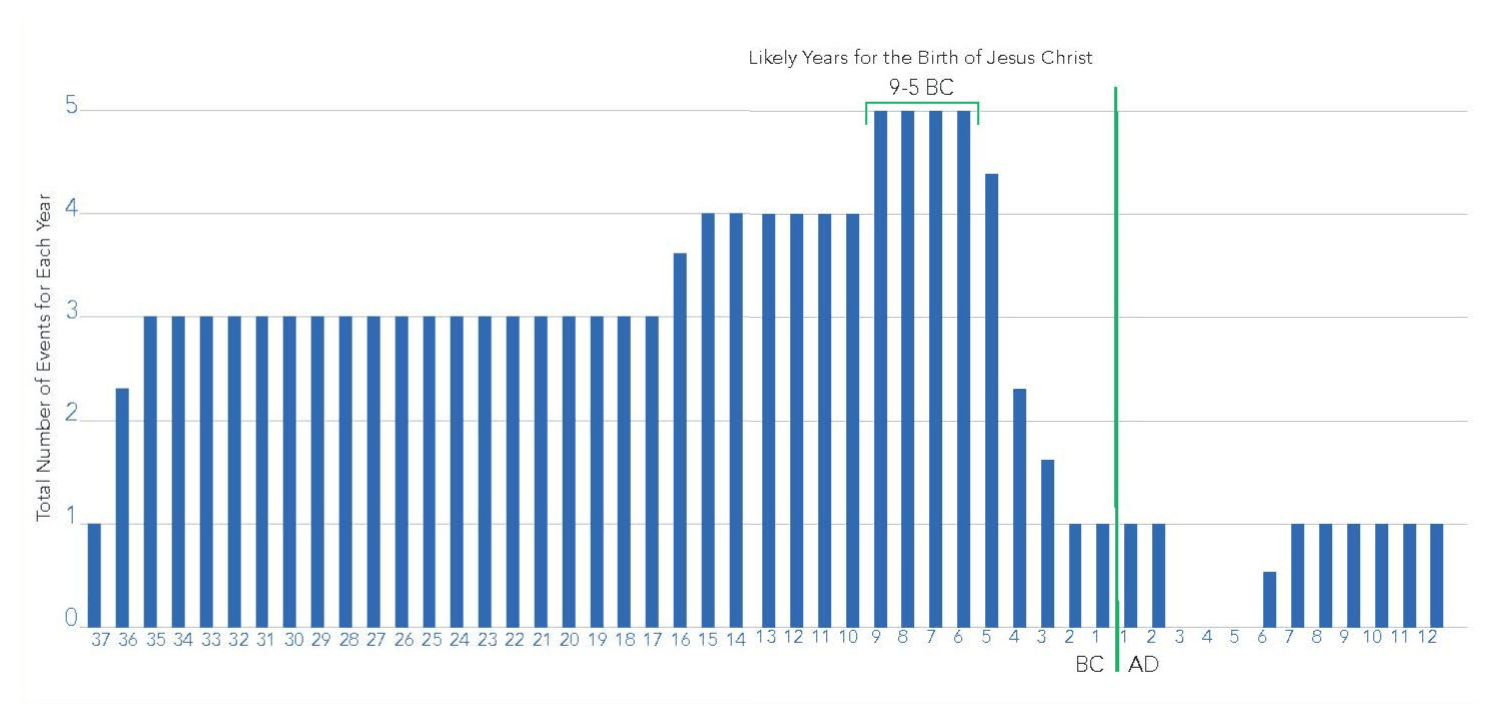
We can now see that there are four years with the most number of historic events: 9-5 BC. We can assume Jesus was born in one of those years.
In order to determine the possible date of Jesus’ birth and the date the Magi saw the Star of Bethlehem, we need to find out if the aforementioned regal portent, Jupiter attending the Sun in Aries, lines up at any time during 9-5 BC. In fact, it happened twice, just before sunset in Judaea on 20th March 6 BC and then again, a month later, on 17th April 6 BC. But which, if either, of these events would the Magi have considered the star? To find the answer, we can look to the Gospel of Matthew itself.
When translating Matthew 2:9 literally from the Greek, we get: “and look the star which they saw in the east led before them until having come it stood upon where was the small child”.
The phrase “in the east” used here is a literal interpretation of the Greek which means “at the rising”. For Greek astrologers, this would refer to a “heliacal” rising – when an object rises before sunrise. So did Jupiter have a heliacal rising in Aries during our time frame of 9-5 BC? Only once – on the morning of 17th April 6 BC.
6. The Star of Bethlehem may have been the planet Jupiter
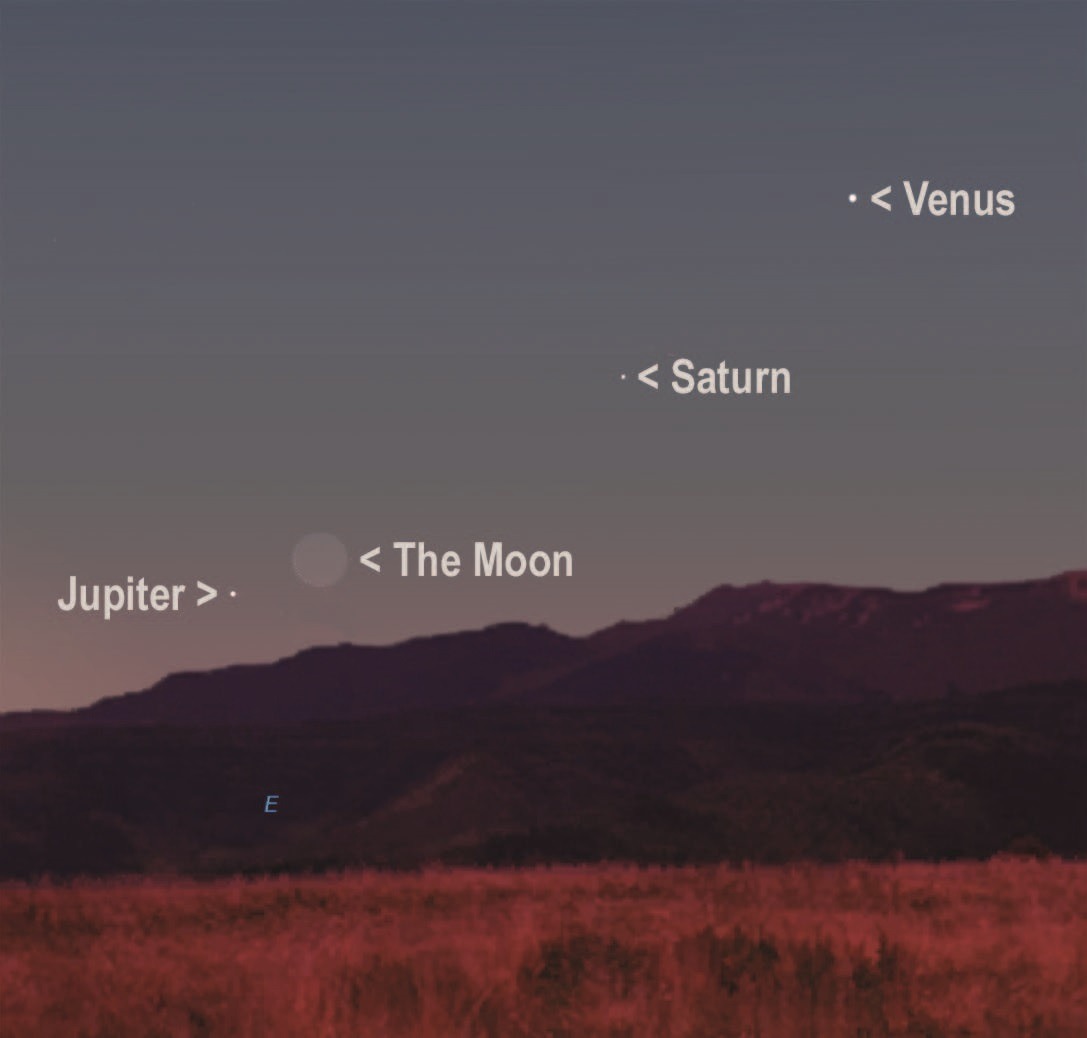
Computer simulation of the sky as it appeared at sunrise on 17th April 6 BC, facing south, near Jerusalem.
We have determined that the star was probably a celestial event – Jupiter attending the Sun in Aries. We also looked at a literal translation of Matthew 2:9 and discovered when the Star most likely appeared – and therefore a strong contender for the date of Jesus’ birth.
Yet there are some more puzzles to solve in this literal translation of Matthew.
The translation reads: “and look the star which they saw in the east led before them until having come it stood upon where was the small child”.
We have come to understand what “in the east” means (“at the rising”) but there are some more confusing phrases here: “went before” and “stood upon”.
The Greek word Matthew uses for “went before” προῆγεν (proegen) is related to an astrological term προηγήσειϛ (proegeseis) which means “to go before” (like the common English translation which reads “went before”), but more precisely “to go in the same direction as the sky moves”.
Fr Douglas explains the astronomy: “from night to night, the stars appear to drift from east to west, while the planets normally drift in the opposite direction, from west to east as they orbit the Sun. Occasionally, a planet may stop its eastward drift, pause, then drift westward “in the same direction the sky moves”, pause again and then return to its original easterly course. This stopping, reversing direction, stopping again and then returning to a normal eastward drift is most easily observed for Mars, Jupiter and Saturn.”
First-century magi would have used the word προηγήσειϛ (proegeseis) to mean a planet changing direction and backtracking towards the west. This fits with Matthew’s account, that the star rose in the east before moving west as it guided the Magi.
Finally, the meaning of the phrase “stood upon” or “stood over”: the Greek word Matthew uses ἐπάνω (epano) can mean “over”, but in Hellenistic astrology, the word would more likely mean “above” as in “above in the sky”. Fr Douglas concludes: “If we interpret the word astrologically, then it means that the planet became stationary “in the sky”, which would, coincidently, be over the child.”
From star charts, Fr Douglas could tell that on 17th April 6 BC, most of the planets were too close to the Sun to be visible, but “after a few days, as the Sun drifted into Taurus, Jupiter became visible as it rose in the east as a morning star.” He could also see that Jupiter drifted eastward, and “stood motionless in the sky on 23rd August for about a week as the earth caught up with it. Jupiter then reversed direction and proceeded westward, in the direction that the sky moves.” Jupiter later stood still for a second time and reached Aries – “the astrological sign representing the place of the newborn king’s birth” – on 19th December. “Matthew describes this as the star that “came to rest over the place where the child was” (Mt 2:9b).”
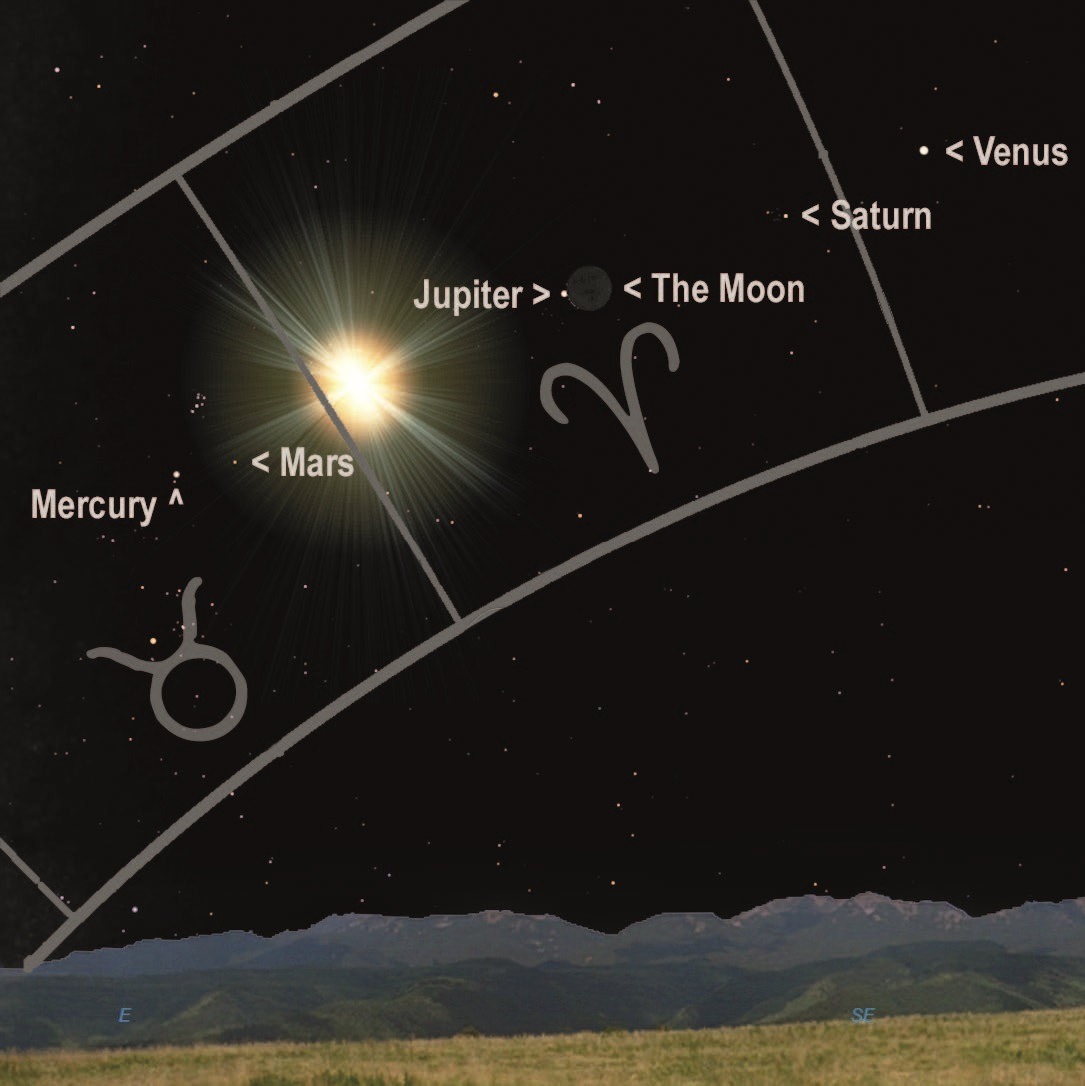
Computer simulation of the sky as it appeared at around 8:10 a.m. on 17th April 6 BC, facing south, near Jerusalem. Atmosphere removed and the band of the zodiac outlined.
All of this helps to explain “why the Magi saw the star, and yet King Herod and all of Jerusalem did not. The early morning occultation of Jupiter by the Moon in Aries was not visible. It was lost in the Sun’s glare. Only because the Magi possessed the ability to calculate celestial positions, could they have known that the Moon had occulted Jupiter during the daytime.”
Unpack the meaning of the Star of Bethlehem in greater detail:
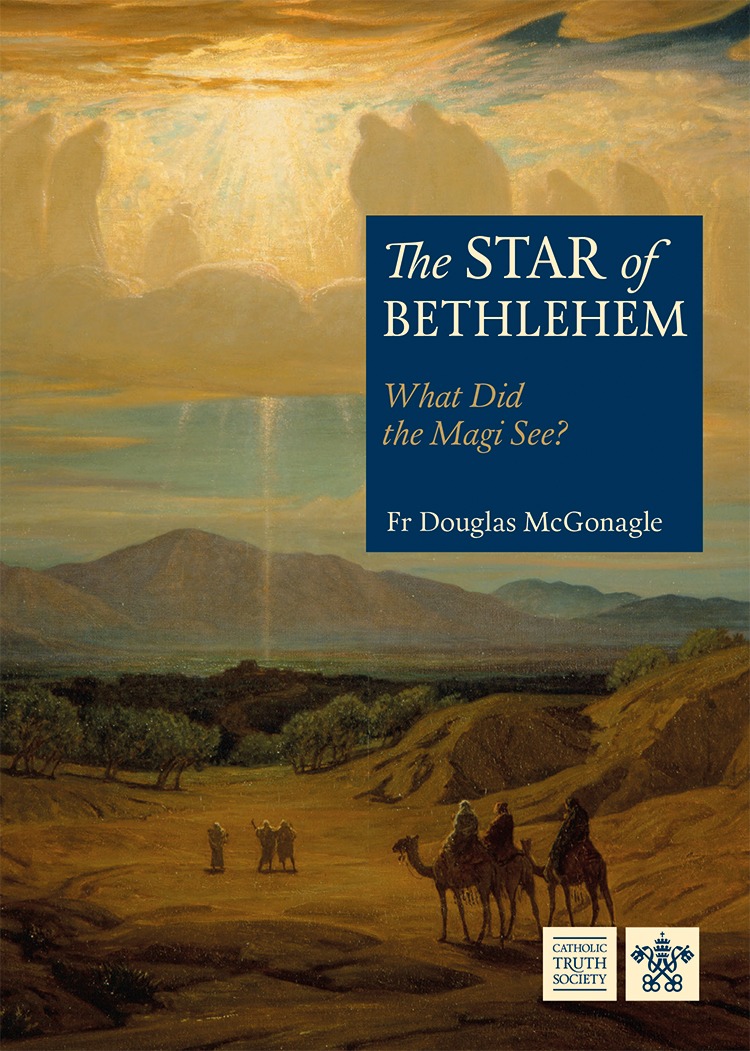 The traditional imagery of the Christmas story paints a vivid scene: a bright star suspended above the Bethlehem stable, like a pinpoint on a vast map, orchestrating the path of the wise men as they journey to honour the newborn Christ. This star has been a source of fascination to many, evoking questions about its true nature. Was it simply a bright light in the sky? A planet or comet? How did it effectively guide the Magi to a humble village in Judea?
The traditional imagery of the Christmas story paints a vivid scene: a bright star suspended above the Bethlehem stable, like a pinpoint on a vast map, orchestrating the path of the wise men as they journey to honour the newborn Christ. This star has been a source of fascination to many, evoking questions about its true nature. Was it simply a bright light in the sky? A planet or comet? How did it effectively guide the Magi to a humble village in Judea?
Before he became a priest, Fr Douglas McGonagle was an astronomer who wondered about the astral phenomenon described in the Gospel account of the Magi. Starting with his knowledge of stars and the Gospels, Fr McGonagle follows a trail of clues through the history and politics of first-century Judea, the principles of ancient astronomy, and even the coinage that circulated in the Roman Empire at the time. What ensues is a compelling account of what the Magi might have seen in the night sky, how it led them to discern the birth of the King of the Jews, and what this means for Christians today.
Order your copy of The Star of Bethlehem today.
